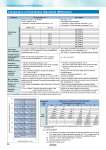
p-e07-11a-sun 93 / 94
10秒後にBOOKのページに移動します
Pneumatic Equipment for Clean Room ISO 14644-1 ISO Class 1 to 9 Intermediate class available U descriptor: Particle diameter less than 0.1 μm M descriptor: Particle diameter exceeding 5.0 μm The number of particles with diameter 0.1 μm or larger in an air volume of 1 m3 is expressed in 10N. ISO Class N: Occupancy state: Sampling particle diameter ISO Class 1 ISO Class 2 ISO Class 3 ISO Class 4 ISO Class 5 ISO Class 6 ISO Class 7 ISO Class 8 ISO Class 9 1 10 102 103 104 105 106 107 108 0.1 1 10 Particle diameter D (μm) Airborne particle concentration, Cn (particles/m3) ISO Class 9 ISO Class 8 ISO Class 7 ISO Class 6 ISO Class 5 ISO Class 3 ISO Class 2 ISO Class 1 ISO Class 4 Cleanliness class (N) ISO Class Maximum concentration limit (particles/m3) Sampling particle diameter (μm) 0.1 0.2 0.3 0.5 1 5 10 100 1000 10000 100000 1000000 1 2 3 4 5 6 7 8 9 2 24 237 2370 23700 237000 10 102 1020 10200 102000 4 35 352 3520 35200 352000 3520000 35200000 8 83 832 8320 83200 832000 8320000 29 293 2930 29300 293000 Note) Concentration data with no more than three significant figures be used in determining the classification level. Note) Fed.Std.209E was abolished in Nov. 2001, so these figures are for reference only. Cn = 10N x (0.1/D)2.08 Standard Fed.Std.209E Note) British unit: Class 1 to 100.000 SI unit: Class M1 to M7 U descriptor: Particle diameter less than 0.1 μm The number of particles with diameter 0.5 μm or larger in an air volume of 1 m3 is expressed in 10 M or coefficient Nc. Cleanliness class: Nc or M q Number of sampling locations: 2 to 9 95% UCL of the mean and the mean of the averages w Number of sampling locations: 1, or 10 or more The mean q Number of sampling locations: 2 to 9 95% UCL of the mean and the mean of the averages w Number of sampling locations: 10 or more The mean Cn British unit: Number of particles/ft = 10N x (0.1/D)2.08 3 = Nc x (0.5/D)2.2 SI unit: Number of particles/m3 = 10 M x (0.5/D)2.2 (SI unit) M1.5 M2.5 M3.5 M4.5 M5.5 M6.5 (British unit) 1 10 100 1000 10000 100000 Cleanliness class Cleanliness class indication Evaluation method using a simple sampling Derive it from the area of the clean room or clean air controlled space. Number of sampling locations NL = (A)0.5 At least one location q Non-unidirectional airflow: at least two locations NL = A x 64/(10 M)0.5 w Unidirectional airflow: at least two locations Smaller value between NL = A/2.32, NL = A x 64/(10 M)0.5 Number of sampling locations 2 litters or a sufficient volume of air that a minimum of 20 particles could be counted if the particle concentration were at the class limit. Min. sampling time: 1 minute 2 litters or a sufficient volume of air that a minimum of 20 particles could be counted if the particle concentration were at the class limit. Min. sampling air flow volume Where only one sampling location is required, take a minimum of three single sample volumes at that location. Total number of samplings in each clean zone: 5 times or more Suction in the same direction as the airflow If the direction of the airflow is not predictable, the inlet of the sampling probe shall be directed vertically upward. 5.0 μm or larger: Constant velocity and suction in the same direction of the air flow 0.5 to 5 μm: Correction possible when it is sucked at a nonconstant velocity Number of samplings Sampling method Comparison of Cleanliness Standards (Reference) Corresponding class indication Calculation of the maximum permitted concentration of particulate cleanliness classes The maximum permitted concentration of airborne particles that are equal to or larger than the sampling particle diameter (D). Cn is rounded down to the nearest whole number, using no more than three significant figures. Cn: N: Class No. (1 to 9), Intermediate class (1.1 to 8.9) D: Sampling particle diameter (μm) 0.1:Constant number (μm) 86